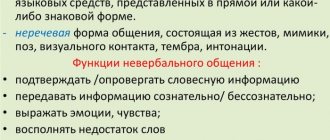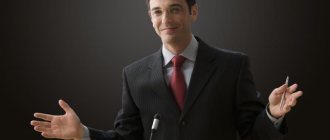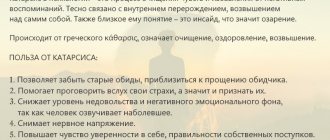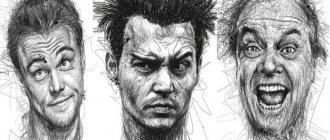Under the influence of the feelings experienced by a person, coordinated contractions and relaxations of various facial structures are born. They determine facial expressions that perfectly reflect the emotions being experienced. Since it is not difficult to learn to control the state of the facial muscles, they often try to mask or even imitate the display of emotions on the face. Knowing facial expressions during various emotions is useful not only for understanding others, but also for carefully practicing your working imitations.
The sincerity of human emotions is usually indicated by symmetry in the display of feelings on the face, while the stronger the falsehood, the more the facial expressions of its right and left halves differ.
Even easily recognizable facial expressions are sometimes very short-lived (fractions of a second) and often go unnoticed; To be able to intercept it, you need a lot of practice or special training. At the same time, positive emotions (joy, pleasure) are recognized more easily than negative ones (sadness, shame, disgust). A person’s lips are particularly emotional, and they are not difficult to read: for example, increased facial expressions or biting of lips, for example, indicate anxiety, and a mouth twisted to one side indicates skepticism or ridicule.
A smile on the face usually shows friendliness or a need for approval. A smile for a man is a good opportunity to show that he is in control of himself in any situation. A woman's smile is much more truthful and more often corresponds to her actual mood. Since smiles often display different motives, it is advisable not to rely too much on their standard interpretation:
- excessive smiling - need for approval;
- a crooked smile is a sign of controlled nervousness;
- a smile with raised eyebrows - readiness to obey;
- smiling with lowered eyebrows - showing superiority;
- a smile without lifting the lower eyelids is insincerity;
- a smile with constant widening of the eyes without closing them is a threat.
Typical facial expressions that communicate emotions are:
- joy: the lips are curved and their corners are pulled back, small wrinkles have formed around the eyes;
- interest: eyebrows slightly raised or lowered, while eyelids slightly widened or narrowed;
- happiness: the outer corners of the lips are raised and usually pulled back, the eyes are calm;
- surprise: raised eyebrows form wrinkles on the forehead, the eyes are widened, and the slightly open mouth has a rounded shape;
- disgust: eyebrows are lowered, the nose is wrinkled, the lower lip is protruded or raised and closed with the upper lip, the eyes seem to be squinting; the person seems to be choking or spitting;
- contempt: the eyebrow is raised, the face is elongated, the head is raised as if a person is looking down at someone; he seems to distance himself from the interlocutor;
- fear: the eyebrows are slightly raised, but have a straight shape, their inner corners are shifted and horizontal wrinkles run across the forehead, the eyes are widened, with the lower eyelid tense and the upper one slightly raised, the mouth can be open, and its corners are pulled back, stretching and straightening the lips above the teeth (the latter just speaks of the intensity of the emotion...); when only the mentioned position of the eyebrows is present, then this is controlled fear;
- anger: the muscles of the forehead are shifted inward and downward, creating a threatening or frowning expression in the eyes, the nostrils are widened and the wings of the nose are raised, the lips are either tightly compressed or pulled back, taking a rectangular shape and exposing clenched teeth, the face often turns red;
- shame: the head is lowered, the face is turned away, the gaze is averted, the eyes are directed downwards or “run” from side to side, the eyelids are covered and sometimes closed; the face is quite flushed, the pulse is rapid, breathing is intermittent;
- grief: eyebrows are drawn together, eyes are dull, and the outer corners of the lips are sometimes slightly lowered.
Knowing facial expressions during various emotions is useful not only for understanding others, but also for carefully practicing (usually in front of a mirror) your working imitations.
Kukish
0
In general, this gesture is characteristic of many cultures. In Rus', they probably learned about the fig from visiting Germans, who tried to seduce Russian young ladies with such a vulgar gesture. There is even a version that “fig” arose from the German expression fick-fick machen (this was the traditional German invitation to intimacy). In the Russian tradition, the symbol of this gesture (probably thanks to highly moral Russian women) was transformed into a designation of categorical refusal. Moreover, over time, “fig” began to be used as a protective remedy against evil spirits: apparently, due to their promiscuity, expats from German lands were equated with demons
×
Slap on the throat
This gesture from the Russian drinking tradition articulated the phraseological phrase “pawn for the tie”, widespread in the 19th and early 20th centuries. This expression was born among officers, and it was invented by a certain Colonel Raevsky, “a talker and a buffoon.” By the way, he “invented” another “drinking” phrase - a little podshefe (chauff?). Interestingly, this gesture was adopted by speculators of strong drinks during the Prohibition Law, which Nicholas II established in the Russian Empire in 1914.
History of Gesture Research
Gestures have been studied for several centuries from different perspectives. Even in ancient times, gestures were considered one of the most important components of rhetorical speech, and their correct use was a means of success for a speaker. Significant attention was paid to gestures in the works of ancient Greek philosophers: Demosthenes, Socrates, Plato, Aristotle. During the Roman Empire, during a period of turbulent political life, which included popular discussion of state laws and debates in the Senate, political eloquence developed most intensively. Ancient Roman philosophers, politicians and orators, such as Cicero, Seneca, Quintilian and others, highlighted the characteristic features of early Roman oratory, in which gesture occupied an important place.
In the Middle Ages, the study of gestures continued. So in 1644 John Bulwer analyzed dozens of gestures and the conditions for their use and published a guide to the use of gestures in order to increase the level of eloquence and understanding of public speaking. 1832 Andrea de Joria published a detailed account of the expression of gestures.
It is believed that speech comes from manual gestures. The first “theory of gestures” belongs to the 18th century philosopher and priest, the abbot of Condillac. This theory was revived in 1973 by American language origin historian Gordon W. Hughes. According to his hypothesis, human spoken speech was preceded by sign language, which began to spontaneously emerge 3 million years BC. e. Then sign language began to be supplemented by a language with 20-40 sounds. Just 100 thousand years BC. That is, the speech of sounds has finally supplanted sign language. Sound speech began to develop intensively only in the last 100 - 40 thousand years BC. e.
Tearing the shirt on the chest
0
It was probably originally an impromptu oath. There is a hypothesis that with such an expressive gesture our ancestors showed their belonging to the Orthodox faith, showing a cross. In addition, it is known that during executions and some corporal punishments, the executors tore the top of the shirt of the punished person. So, the voluntary tearing of clothes as a persuasive argument was intended to show a person’s readiness to climb to the chopping block for the truth.
Classification of gestures
In the scientific literature, there are various approaches to identifying different types of gestures.
Conditional and unconditional gestures
Conventional gestures are gestures used by certain peoples, social or professional groups (saluting in the military; nodding the head in Ukrainian - “yes”, in Bulgarians - “no”, etc.).
Unconditional gestures are gestures that perceive everything without prior explanation. Among them are:
- pointing gestures, during which a person shows with his hand the location of an object (“there”, “here”);
- descriptive gestures depicting the nature of the movement (he said “watermelon” and made a circle with his hand);
- expressive gestures (threat gesture);
- rhythmic gestures merge with the rhythm of sound, words, emphasizing all its rhythm (gesture-conductor while chanting words);
- imitation gestures reflecting the gestures of another person (“He made his head like this and said…”) ..
Sign and non-sign gestures (they are distinguished by their role in communication)
Iconic gestures are directly related to the transfer of information and have a content plan; gestures are distinguished:
- demonstratives, the function of which is to highlight some part of the space around the speaker;
- pictorial (iconographic), which always have a real prototype, the features of which are attempted to be conveyed by the one who is gesturing;
- symbolic, usually have an abstract meaning, they are only traditionally attributed to a specific gesture and therefore are understood within one team (in the general case, within national boundaries). The difference between figurative and symbolic gestures is well illustrated by the difference between pictographic and ideographic writing: a figurative gesture is a pictogram, a symbolic gesture is a hieroglyph.
Unfamiliar gestures include:
- rhythmically. The rhythm of an utterance in colloquial speech is a uniform alternation of acceleration and deceleration, which is created and emphasized by the repetition of the same type of intoneme and at the same time the same gesture in some cases and switching to a new type of intoneme and, accordingly, a new type of gesture in others.
- emotional - gestures are purely individual, their use largely depends on the skills and character of the speaker. An emotional gesture is “read” in accordance with facial expressions and intonation of speech.
Goat
As a rule, this gesture is mistakenly associated with criminal “fingering” or fans of “metal”. In fact, the “goat” is already several thousand years old, and it was associated with protection from black magic, from evil spirits. Probably, the older generation still remembers the nursery rhyme “The horned goat is coming for the little guys...”, when an adult is shown how a goat butts, depicting goat horns using the little finger and index finger of the right hand. In fact, this is not just a game with a child - this is how our ancestors removed the evil eye from children. In addition, ancient Greek speakers accompanied their speeches with a “goat” - this configuration meant “instruction.” This gesture was adopted from ancient rhetoricians by Christian priests, who often accompanied their sermons with a “goat.” It is curious that on some Orthodox icons you can see the Savior and saints with their little finger and index finger extended forward.
Gesture processing in the brain
Scientists have long known that recognition of speech and written characters occurs in the same parts of the brain, since both methods of communication between people are subject to certain rules of grammar and have the same vocabulary inherent in them.
Modern research conducted by scientists from the National Institute on Deafness and Other Communication Disorders of the United States aimed to find out how certain lobes of the brain are associated with the processing of human gestures that are not directly related to language, but carry a meaning that is understandable to everyone and without the need to translate it into language of words and letters. Two types of gestures were used - pantomimes, with the help of which people imitate objects or actions, and gestures, emotionally and abstractly symbolizing the messages that people exchange when communicating. Scientists have found that human gestures, like spoken words or written symbols, are processed by the same parts of the brain - the left inferior frontal gyrus (Broca's area) and the posterior middle temporal gyrus, the posterior superior temporal sulcus and the superior temporal gyrus (Wernicke's area). This may indicate the evolutionary prerequisites for the emergence of language and speech among human ancestors. Because these parts of the brain have long been known to scientists as speech centers involved in recognizing words and selecting the most appropriate meanings for them from the stock available in the brain. Today, scientists believe that these areas of the brain are responsible for identifying the meaning of any new sign received. If this theory is correct, then our modern speech centers, according to Dr. Allen Brown, are the product of the evolution of these lobes of the brain, capable of processing the meaning of both words and gestures.
Finger to temple
1
A finger to the temple is an international gesture. Among the Germans and Austrians it means “crazy!”, and in a number of African cultures it means that a person is deep in thought. In France, a finger to the temple means that a person is a fool, and in Holland, on the contrary, that he is smart. In Russia they twist it at the temple when they want to show that the interlocutor is “a little bit of that”, that he has “balls for rollers.”
Tactile movements
Embrace
The meaning of the expressed feelings is determined by the nature of the hug, its duration and strength. For example, bosom friends who have not seen each other for a long time literally strangle each other in their arms when they meet. At wrestling competitions, participants briefly hug and quickly return to their respective corners. Lovers linger in a tender embrace for a long time, clinging together, demonstrating serene happiness, clinging tightly - passion or the fact that they miss you. The hugs of distant relatives depend on previously maintained relationships; they can be cold, reserved, or passionate. The hugs of loved ones are soft and sincere.
Handshakes
The open palm has long been a gesture of trust. The handshake itself dates back to ancient times: primitive people shook hands to demonstrate that they were not armed and were peaceful. And during the heyday of the Great Roman Empire, this gesture changed somewhat - people began to shake hands by the wrists. The common habit of hiding a dagger in the sleeve played a role, but the meaning is the same: to show good disposition, the absence of hidden weapons.
Such a gesture is firmly entrenched in our subconscious and we, just like our ancestors, extend our hands to each other as a sign of trust, or try to hide our palms when we are hiding something.
By vigorously shaking your hand combined with a joyful exclamation, you can easily determine the sincerity of your interlocutor and his desire to continue communication. When they clasp a hand with both of theirs, in the form of a “glove,” they also demonstrate friendliness. But when they offer you a “lifeless”, limp hand, it means that they don’t want to contact you.
If the hand is cold when shaking, then this is a signal that its owner is cold, or is seriously excited. Steamy palms also indicate a nervous experience. When, when shaking, the hand turns out to be palm down, this indicates the desire of its owner to dominate the other person. On the contrary, a hand turned palm up communicates that a person unconsciously recognizes himself as a subordinate and agrees to be led in relations with his interlocutor.
Patting on the shoulder or back
These nonverbal gestures are very typical for men. They often symbolize friendship, encouragement, or concern. In addition, patting the shoulder or back demonstrates masculine strength, the ability to support in a difficult situation, and the willingness to help if necessary.
Touch
Touches can be light, affectionate, gentle, strong, rough. Nonverbal communication and touching gestures are most common in relationships that are intimate or involve strong emotions.
Stopping touches - when it is necessary to stop a mischievous mischief-maker. Attracting attention - when the interlocutor does not hear or does not want to listen. Setting up an intimate mood - in the case of sexual foreplay. Very often, touches are an indicator of the unexpressed feelings of a loved one: tenderness, care, love, disagreement, irritation, aggression.
Among other things, they can be an excellent means of manipulation. For example, a careful but firm touch on the elbow of your interlocutor can make the latter trust you. By holding a person by the elbow, you subconsciously inspire him that you can be trusted, that you can be relied upon, that you are a reliable support for him. This gesture is very often used by scammers, instilling in the victim a sense of security, a feeling that he wants to help, and is concerned about the well-being of the victim. Therefore, be vigilant and do not allow such touching by strangers.
Russian bow
0
In Rus' it was customary to bow when meeting. But the bows were also different. The Slavs greeted a person respected in the community with a low bow to the ground, sometimes even touching or kissing it. This bow was called the “great custom.” Acquaintances and friends were greeted with a “small custom” - a bow from the waist, and strangers with almost no custom: putting a hand to the heart and then lowering it down. It is interesting that the gesture “from the heart to the earth” is originally Slavic, but “from the heart to the sun” is not. Any bow metaphorically (and physically too) means humility before your interlocutor. There is also a moment of defenselessness in it, because a person bows his head and does not see the person in front of him, exposing him to the most defenseless place of his body - his neck.
Examples of nonverbal communication
- If a girl, showing off her wrist, communicates with a member of the opposite sex, she lets him know that she is ready to get closer to him. And if he also paints his lips with bright lipstick, then he has truly become the object of her passion.
Read more: How to know that a girl likes you - 14 signs
- There is a common method of establishing contact with new acquaintances: you should copy his gestures and postures. If the interlocutor crossed his arms, you can repeat this body movement. This manipulation promotes non-verbal unity. There is a whole set of such small tricks.
To grasp the true meaning, you need to pay close attention to the position of the interlocutor's hands and feet.
Mainly gestures and postures emphasize the truth, and sometimes contradict what was said.
It is difficult to believe a person with crossed limbs convincing another of good intentions. It is unlikely that he will fulfill his promise. Surely he uses the location and trust of his partners for his personal interests.
Through gestures and posture you can hide some information from your opponents. Despite the casualness and ease of communication, the posture makes it clear that the owner does not intend to share important information with anyone.
Show your nose
0
The gesture of the thumb at the nose - “show nose” - is one of the most widely known, but relatively not often used. He is known not only in Russia. In Italy it is called “palm tree on the nose”, in France - “fool’s nose”, in the UK there are several at once - the five-finger greeting, the Shanghai gesture, the Queen Anne fan, the Japanese fan, the Spanish fan, coffee grinding. Associations of this sign with coffee grinding arose, in particular, from Charles Dickens. There is an assumption that the “show nose” gesture originally represented a grotesque portrait of a long-nosed man. Nowadays it is considered a teasing sign in children, and the expression “to show your nose” is synonymous with the verb “to deceive” in the sense of “to deceive”.











